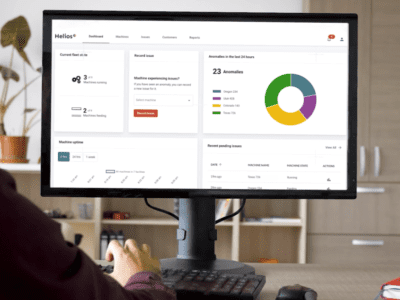The maintenance of corrugated machinery involves a lot of nuance – hundreds of thousands of moving parts, each working in tandem and each with its own set of responsibilities and maintenance needs. As parts undergo natural wear and tear from use, they must be carefully monitored to prevent costly downtime caused by failure or related breakdowns. Sometimes, as parts begin to wear out, there are telltale signs, such as decreased output speed, more frequent jams, sounds, and smells, but not all components create such obvious, detectable signs that maintenance is needed. Even with careful adherence to a PM schedule, and even with the most experienced, seasoned operators on the lookout for anomalies, there can still be catastrophic failures or unforeseen malfunctions that take machines offline. As technology advances, there are new ways to leverage early signs of potential issues to detect, and more importantly, predict problems before they happen. That technology has a name: Data Science and it is the key to increasing uptime and profitability of corrugated box plants around the world.
What Is Data Science?
At its most basic level, data science is the intersection of expertise in a specific field, and the gathering, storing, and application of data produced within that field to uncover useful insights that otherwise elude detection or easy perception. Data science is used around the world, spanning every discipline, from detecting and preventing diseases to optimizing baseball rosters; from stopping tax fraud to finding a romantic connection, and everything in between. The field of data science requires a combination of sophisticated data collection and specialized knowledge in the area or field in which the data is to be applied. Depending on the age of the equipment in the facility, corrugated equipment may already be generating and storing volumes of data. However, in most cases, this data is either only looked at retrospectively, or it is not being analyzed at all. Much of this information can be applied insightfully by data scientists to optimize maintenance intervals and equipment performance. But the truly robust ability to predict failures before they begin all comes from another more specialized process called anomaly detection.
What Is Anomaly Detection?
Anomaly detection is a concept used for mining data from machines and other Industrial Internet of Things (IIoT) devices. And while this sounds complicated, at its essence, is the ability to look for any type of activity that breaks with the norm. In corrugated, an anomaly could amount to a strange noise, a jam or lag somewhere on the line, a shudder or vibration that is unexpected, or any number of other occurrences that is unusual.
Even with careful adherence to a PM schedule and the most experienced, seasoned operators, there can still be catastrophic failures or unforeseen malfunctions that take machines offline.
The real utility in applying data science to corrugated lies in predictive maintenance and optimization of maintenance schedules.
While on the surface, each anomaly may be minor if not completely meaningless, detecting and cataloging these anomalies is incredibly insightful to a data scientist, because the anomalies can then be mapped to other problems or breakdowns. When coupled with other operating data and retrospective labeling by machine operators about which anomalies ultimately lead to what specific problems, data scientists and machine learning algorithms can learn to read patterns in machine activity, and they can ultimately be used to alert operators to impending problems while there is still time to fix them.
Increased Profit, Productivity
The real utility in applying data science to corrugated lies in predictive maintenance and optimization of maintenance schedules. With insight that can detect issues before they start, a proactive approach can be taken to maintenance. Rather than having a machine unpredictably break down during a big project or during peak hours, data science can instead alert the operators and facility managers to a need for maintenance while there is still time to schedule it during non-peak hours. This type of changeover can also happen as routine parts replacement rather than a major repair, which ultimately means lower cost. Think of it as a low engine oil indicator light clicking on in a car, as opposed to a bone-dry engine seizing up and failing completely – the cost savings on the labor alone is enormous, and it is a matter of a quick trip to an auto parts store for an oil top-off, instead of sending the car back to the dealer or even the factory for repair. Another crucial benefit is more accurate maintenance intervals potentially extending the lifespan of parts. Without the use of data science, it is up to a maintenance manual to provide what is essentially an estimate of when a replacement should happen. For another automotive example, this equates to changing a timing belt – there is a recommended mileage interval for changing a timing belt, but nobody really knows when a timing belt is failing until it actually fails. So while changing it out at 100,000 miles preempts major maintenance, you may be spending a day or two without your car and paying for a new timing belt while your existing timing belt is still good for another 30,000 miles. Likewise, data science applied to anomaly detection can lead to a true assessment of when failures are imminent, so costs on suggested maintenance can be deferred until maintenance is actually required.
How To Get Started
Data science as applied through machine learning is not new to the world of manufacturing, but it has just recently begun bursting onto the scene in corrugated. Our manufacturer agnostic machine learning platform for corrugated, Helios, has begun rolling out its anomaly detection machine learning dashboard as of Spring 2021. It is important to note that this does not simply replace the need for maintenance personnel, but rather, requires their buy-in and expertise to help the algorithm become “smarter.” When equipping the Helios platform, operators catalog anomalies over a series of weeks and months. Over time, this allows the algorithm’s machine learning to take place, which can lead to predictive maintenance reminders and other insight and analysis for optimizing maintenance intervals and maximizing uptime. Ultimately, Helios serves as a tool that expands and sharpens the insight of the existing maintenance operators, who are now able to couple their own experience with new unprecedented levels of detail detected by the Helios algorithm, increasing uptime and maximizing the profitability of the facility as a whole.
Mark Peyton is the Director of Aftermarket at SUN Automation Group. He brings decades of industry experience and expertise to SUN where he has held many customer-focused positions. Prior to his 20-year career with SUN, he worked from Langston and United. He can be reached at mpeyton@sunautomation.com or 410-472-2900
Originally published in Corrugated Today, July/August 2021 Issue


 Top Print vs Bottom Print Flexo Folder Gluer: 3 Pros & Cons
Top Print vs Bottom Print Flexo Folder Gluer: 3 Pros & Cons